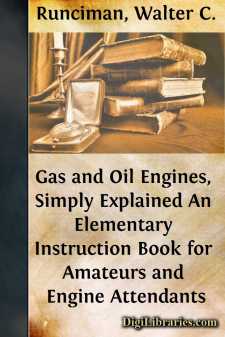Categories
- Antiques & Collectibles 13
- Architecture 36
- Art 48
- Bibles 22
- Biography & Autobiography 813
- Body, Mind & Spirit 142
- Business & Economics 28
- Children's Books 14
- Children's Fiction 11
- Computers 4
- Cooking 94
- Crafts & Hobbies 4
- Drama 346
- Education 46
- Family & Relationships 57
- Fiction 11829
- Games 19
- Gardening 17
- Health & Fitness 34
- History 1377
- House & Home 1
- Humor 147
- Juvenile Fiction 1873
- Juvenile Nonfiction 202
- Language Arts & Disciplines 88
- Law 16
- Literary Collections 686
- Literary Criticism 179
- Mathematics 13
- Medical 41
- Music 40
- Nature 179
- Non-Classifiable 1768
- Performing Arts 7
- Periodicals 1453
- Philosophy 64
- Photography 2
- Poetry 896
- Political Science 203
- Psychology 42
- Reference 154
- Religion 513
- Science 126
- Self-Help 84
- Social Science 81
- Sports & Recreation 34
- Study Aids 3
- Technology & Engineering 59
- Transportation 23
- Travel 463
- True Crime 29
Gas and Oil Engines, Simply Explained An Elementary Instruction Book for Amateurs and Engine Attendants
Categories:
Description:
Excerpt
CHAPTER I
INTRODUCTORY
The history of the gas engine goes back a long way, and the history of the internal combustion engine proper further still. It will be interesting to recount the main points in the history of the development of the class of engine we shall deal with in the following pages, in order to show what huge strides were made soon after the correct and most workable theory had been formulated.
In 1678 Abbé Hautefeuille explained how a machine could be constructed to work with gunpowder as fuel. His arrangement was to explode the gunpowder in a closed vessel provided with valves, and cool the products of combustion, and so cause a partial vacuum to be formed. By the aid of such a machine, water could be raised. This inventor, however, does not seem to have carried out any experiments.
In 1685 Huyghens designed another powder machine; and Papin, in 1688, described a similar machine, which was provided with regular valves, as devised by himself, in the Proceedings of the Leipsic Academy, 1688. From this time until 1791, when John Barber took out a patent for the production of force by the combustion of hydrocarbon in air, practically no advancement was made. The latter patent, curiously enough, comprised a very primitive form of rotary engine. Barber proposed to turn coal, oil, or other combustible stuff into gas by means of external firing, and then to mix the gases so produced with air in a vessel called the exploder. This mixture was then ignited as it issued from the vessel, and the ensuing flash caused a paddle-wheel to rotate. Mention is also made that it was an object to inject a little water into the exploder, in order to strengthen the force of the flash.
Robert Street's patent of 1794 mentions a piston engine, in the cylinder of which, coal tar, spirit, or turpentine was vaporised, the gases being ignited by a light burning outside the cylinder. The piston in this engine was thrown upwards, this in turn forcing a pump piston down which did work in raising water. This was the first real gas engine, though it was crude and very imperfectly arranged.
In 1801 Franzose Lebon described a machine to be driven by means of coal-gas. Two pumps were used to compress air and gas, and the mixture was fired, as recommended by the inventor, by an electric spark, and drove a piston in a double-working cylinder.
The atmospheric engine of Samuel Brown, 1823, had a piston working in a cylinder into which gas was introduced, and the latter, being ignited, expanded the air in cylinder whilst burning like a flame. The fly-wheel carried the piston up to the top of its stroke, then water was used to cool the burnt gases, which also escaped through valves, the latter closing when the piston had reached the top of its stroke. A partial vacuum was formed, and the atmospheric pressure did work on the piston on its down stroke. A number of cylinders were required in this engine, three being shown in the specification all connected to the same crank-shaft. According to the Mechanic's Magazine, such an engine with a complete gas generating plant was fitted to a boat which ran as an experiment upon the Thames.
A two-cylinder engine working on to a beam was built in Paris, but no useful results were obtained.
Wright's engine of 1833 used a mixture of combustible gas and air, which operated like steam in a steam engine. This engine had a water-jacket, centrifugal governor, and flame ignition. In 1838 Barnett applied the principle of compression to a single-acting engine. He also employed a gas and air pump, which were placed respectively on either side of the engine cylinder, communication being established between the receiver into which the pumps delivered and the working cylinder as the charge was fired. The double-acting engines which Barnett devised later were not so successful....


